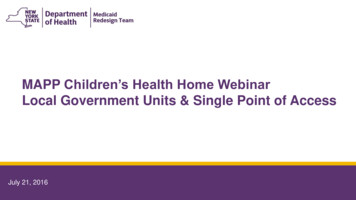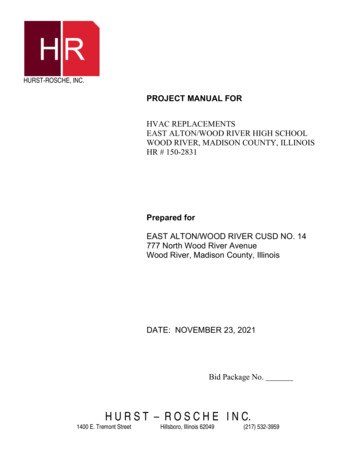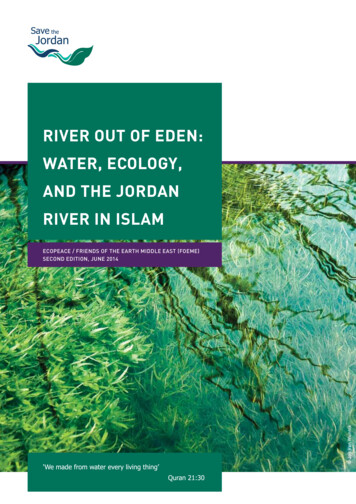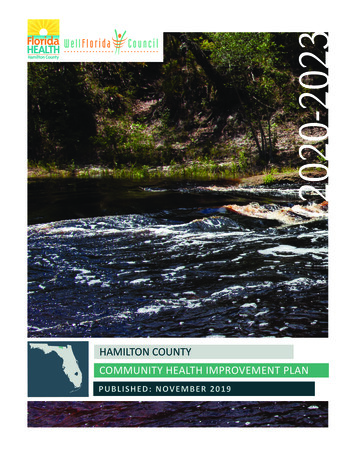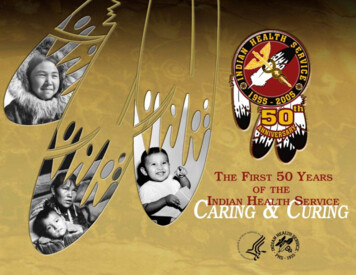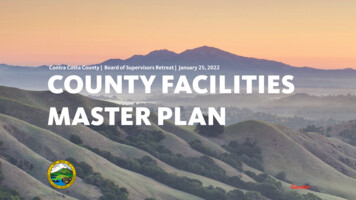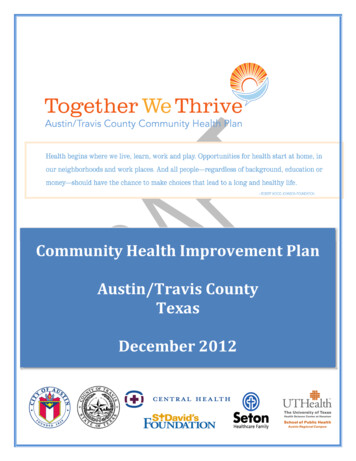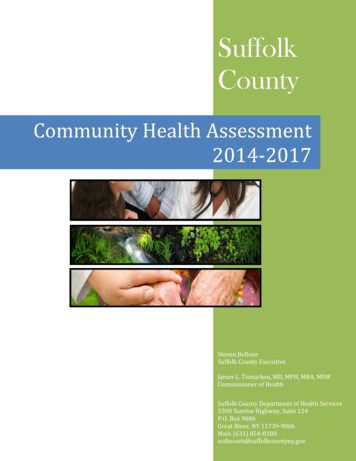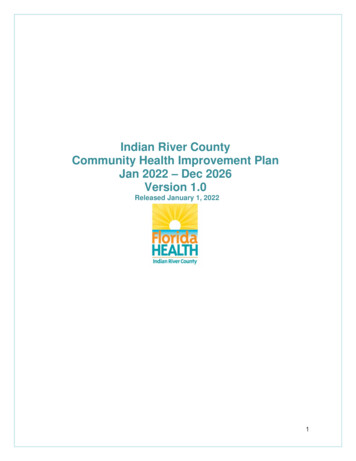
Transcription
Indian River CountyCommunity Health Improvement PlanJan 2022 – Dec 2026Version 1.0Released January 1, 2022FionasHEALTHIndian River County1
Indian River CountyCommunity Health Improvement PlanJan 2022 – Dec 2026Version 1.02
Table of ContentsExecutive Summary . 4Acknowledgments . 5Introduction. 6Timeline . 7Indian River County Snapshot . 8Demographic and Socioeconomic Profile. 8Health Status Profile . 8Health Resources Availability and Access Profile. 9Community Perspective . 10The Process . 11Community Health Needs Assessment . 12Continued Improvement through Partnership . 13Methodology . 13Community Health Improvement Plan. 15Overview. 15Priority 1: Health . 17Why is it a Priority? . 17Health Action Plan. 18Goal 1.A: Improve the Mental Health of Individuals in Indian River County . 19Goal 1.B: Ensure Individuals in Indian River County Attain and Maintain aHealthy Weight. 20Evidence-Supported Initiatives . 22Community Resources . 23Priority 2: Housing . 24Why is it a Priority? . 24Housing Action Plan . 25Goal 2.A: Increase the Number of Affordable Housing Units by 1500 in Indian RiverCounty by 2026. 25Goal 2.B: Establish a Comprehensive Integration of Support Services Around HousingAttainment and Retainment in Indian River County by 2026 . 26Evidence-Supported Initiatives . 27Community Resources . 27Priority 3: Economic Opportunity and Employment. 29Why is it a Priority? . 29Mental Economic Opportunity and Employment Action Plan . 30Goal 3.A: Reduce Barriers by Creating Economic Opportunity and IncreasedEmployment by 2026. 30Goal 3.B: Decrease the Individual Poverty Rate 10% by 2026 by Providing Stepsand a Network of Providers to Advance out of the Poverty Cycle . 30Evidence-Supported Initiatives . 32Community Resources . 33Health Equity . 34Using the Plan and Getting Involved 34Appendix A – Priority 1: Health Action Plan . 35Appendix B – Priority 2: Housing Action Plan . 39Appendix C – Priority 3: Economic Opportunity and Employment Action Plan . 42Appendix E – Revisions to the CHIP . 44Appendix F – CHIP Goal Alignment with Local and State Plans . . .453
Executive SummaryThe Indian River County Community Health Improvement Plan (CHIP) is the product ofcontinuous improvement through diverse partner engagement. The broad spectrum ofstakeholders dedicated time, energy and resources to creating an actionable five-year plan forIndian River County with the hope of improving the quality of life of residents in Indian RiverCounty.The CHIP was developed in context of the vision, mission and values set forth by the FloridaDepartment of Health in Indian River County (DOH-Indian River). This community-driven planis the result of ongoing input and participation of countless individuals, agencies andorganizations.An advisory committee composed of individuals representing county government, non-profitorganizations and Florida Department of Health in Indian River County (DOH-Indian River)began meeting in March 2019 to develop a Community Health Assessment (CHA). The focusof the meetings was to analyze data and identify the health need priorities of the residents ofIndian River County and make recommendations for future policy and systemic change.Using the health need priorities identified by the advisory committee as a basis, work beganon the Community Health Improvement Plan (CHIP), a framework and a plan of action toimprove health outcomes of the residents of Indian River County over the next five years.Three working groups were formed to focus on each identified health priority. The workinggroups also integrated Health Equity as a component of each of the three health priorities.The CHIP development process was facilitated by DOH-Indian River. The process includedassessing the health needs of the community, prioritizing health needs and devising animprovement plan through strategic planning. The identified health priorities outlined in thisplan are based on the review of quantitative data and qualitative data from various keystakeholders and community members. The top health priorities identified during this processare: HealthHousingEconomic Opportunity & EmploymentTo appropriately align goals, objectives and strategies with the health priorities of the county,the advisory committee determined to identify the root causes of each priority. Factorscontributing to the health priorities are reflected in the Indian River County CHIP.Successively, members of the advisory committee formulated goals and objectives, as well asoutlined action steps for each health priority.4
AcknowledgmentsThe 2022-2026 Indian River Community Health Improvement Plan is a product of partnershipand participation among a broad spectrum in the public health system that came together toimprove the quality of lives of individuals residing in Indian River County. Stakeholders, alongwith community members, came together to improve services in Indian River County. Theparticipation and dedication of these individuals, as advocates for their agencies and thepopulations they serve, brought tremendous value to the community health improvementplanning process.Florida Department of Health in Indian River wishes to extend our appreciation to all theorganizations who committed to improving access to health care on behalf of the residents ofIndian River County. Their insights were essential to identifying health need priorities anddeveloping an improvement plan focused on creating a healthier Indian River County. Specialrecognition is due to the following entities that served on the Advisory Committee panels and/orplayed a valuable role in community health improvement planning process: 211 Palm Beach/Treasure CoastCareerSource Research CoastCity of FellsmereCleveland ClinicCoalition for Attainable HomesEconomic Opportunities Council of IndianRiver County, Inc.Fellsmere Action Community Team (FACT)Fellsmere Community Prayer and WorshipCenterFlorida Department of Health - Indian RiverCountyGrandparents Raising GrandchildrenHead Start, Indian River CountyHomeless Children’s Foundation of IndianRiver CountyHope for Families CenterIndian River County Board of CountyCommissionersIndian River County Chamber of CommerceIndian River County CommunityDevelopment DepartmentIndian River County Habitat for HumanityIndian River County Healthy Start Coalition,Inc.Indian River County Human ServicesIndian River County Metropolitan PlanningOrganizationIndian River County National Association forthe Advancement of Colored People(NAACP)Indian River County Parks and RecreationIndian River County Sheriff's OfficeIndian River Community Foundation Indian River Hospital DistrictJohn’s Island Community Service LeagueMarsh LandingMending PiecesMental Health Association in Indian RiverCounty, Inc.Mental Health Collaborative of Indian RiverCountyNurse Family Partnership of the TreasureCoastRobert Solari, Indian River County Board ofCounty commissioners, retiredSenior Collaborative of Indian River CountySenior Resource AssociationSubstance Awareness Center of Indian RiverCountyTechnology PartnersThe Arc of Indian River CountyThe Mental Health Collaborative of IndianRiver CountyTreasure Coast Community HealthTreasure Coast Homeless Services Council,Inc.Treasure Coast Technical CollegeUnited Against PovertyUnited Way of Indian River CountyVisiting Nurse Association of the TreasureCoast5
IntroductionFor the first time in a decade, in 2019 major funding organizations, donor groups, Countygovernment and community leaders came together to conduct a comprehensive CommunityNeeds Assessment (CNA). Over a span of one year, the group worked together with anindependent consultant to gather, review and analyze information. Over 50 nonprofit agenciesparticipated through their leadership, their staffs and their clients. Recent studies were included,and a wide range of subject matter experts were consulted. Surveys published in Creole, Englishand Spanish were distributed to residents from across the County, including those that are mosteconomically challenged, giving them the ability to express their needs in writing, or verbally duringfocus groups.This CNA forms the foundation of the Community Health Improvement Plan (CHIP) in Indian RiverCounty. The CHIP assessed the health needs of Indian River County through the collection,compilation and review of quantitative and qualitative data. The results of this assessment wereused to aid in the identification of health needs priorities in Indian River County by a diverse groupof stakeholders forming three working groups.The CHIP is a strategic and actionable plan for improving health outcomes in Indian River Countyfrom 2022 to 2026. The CHIP is a set of goals, objectives and activities set forth by the workinggroups to help guide planning efforts for health policymakers, stakeholders and health careproviders in Indian River County.6
TimelineApril 2019A group of individuals representing county government, non-profitorganizations and Florida Department of Health in Indian River County(DOH-Indian River) engaged the Q-Q Research to facilitate theCollaborative Community Health Needs Assessment (CHNA) process.January 2020A Community Assessment Survey (CAS) was developed and distributedto Indian River County communities including: Fellsmere, Wabasso,Roseland, Orchid, Windsor, Oslo Park / Vero Highlands, City of VeroBeach, West Vero Beach, Gifford, West Wabasso, Winter Beach,Summer Place, Florida Ridge, Dixie Heights and Sebastian.May 2020Results of the CAS were collected, and recommendations were madebased on the results of the survey and data complied between 2014 and2018.November 2020A Community Health Assessment and planning stakeholder meeting washeld to review the community needs assessment and CAS results.Consensus on the top three priorities issues based on current data andchanging needs were health, housing and economic opportunity andemployment.Early 2021Three working groups were assembled as the foundation of theCommunity Health Improvement Plan (CHIP) from local organizations,government agencies and community members actively involved in theheath, housing and economic improvement fields.May 2021The first meetings for each of the panels reviewed qualitative andquantitative data relating to health, housing and economic opportunityand employment in Indian River County.June 2021The second meeting of the panels identified and selected goals andobjectives.July 2021The third meeting of the panels identified and selected objectives andactions.October 2021The fourth meeting of the panels reviewed and refined a draft of theCHIP.November 2021Florida Department of Health in Indian River (DOH-Indian River),Performance Management Council reviewed the draft CHIP andapproved it for finalization and submission.December 2021Finalized CHIP2022 - 2026CHIP Implementation7
Indian River County SnapshotDemographic and Socioeconomic Profile The population census, 2020 in Indian River County was 159,788, 0.74% of Florida’spopulation, and has been steadily increasing since 2009.Nearly a third (32.4%) of the residents in the county are 65 years or older, which is morethan the rate of Florida, which is 20.4%.Just under a fifth (18.3%) of individuals in Indian River County are under 19 years of age.In 2019, 74.5 % of the population identified as White and 9.3% identified as Black or AfricanAmerican. Additionally, 12.9% of the residents in Indian River County identified as Hispanic.In 2019, 12.1% of Indian River County residents lived below the poverty level, which isunder 26,500 for a family of four.In 2019, 27.1% of residents who identified as Black or African American lived below thepoverty line, higher than any other racial or ethnic group by at least 10%, which representsa racial disparity.Geographically, Fellsmere (32948) and Vero Beach (32960 and 32967) had over 25% ofresidents living below the federal poverty line in 2019.In Indian River County, 7.3% of the labor force was unemployed, higher than the state at6.4%; however, percent unemployment has been decreasing steadily since 2014.In 2020 (pre-COVID), the protective factor prevalence rates (family opportunities andrewards for prosocial involvement, school opportunities and rewards for prosocialinvolvement, and religiosity) for middle and high school students was 51%.In the 2019-20 school year, the high school graduation rate in Indian River County was93.4%, higher than that of Florida (90.0%).In 2019, 10.6% of the population 25 years and over did not have a high school diploma orGED.In 2019, 33% of adults in the county were “housing cost-burdened” (paying more than 30%of their monthly income on rent or mortgage).Health Status Profile In 2019, nearly 3 out of 5 adults (59.7%) in Indian River county were overweight or obese.Of these, 58.0% were male and 51.9% were female.The rate of obesity among adults in Indian River County in 2019 was 25.6%, lower than thestate’s rate of 27.0%.In 2020, 68.1% of middle and high school students in Indian River County were at a healthyweight, compared to 65.3% statewide.From 2010 to 2020, the rate of students at or above the 95th percentile in BMI in the countyincreased from 9.5% to 10.5% for middle school and from 10.6% to 12.9% for high school.In 2019, 26.7% of Indian River County adults were sedentary. However, of non-HispanicBlack adults, 40.9% were sedentary; and individuals earning less than 50,000 annuallywere also twice as sedentary as those earning more.In 2019, 20.5% of Indian River County adults engaged in heavy or binge drinking, the 8thhighest county rate in Florida and higher than the state rate of 18.0%.In 2020 (pre-COVID), 20.9% of Indian River County high school students had beenexposed to at least four ACEs (Adverse Childhood Experiences); exposure to four or moreACEs is considered a high level of trauma.8
In 2020 (pre-COVID), the ACE most frequently experienced by high school students wasparents separated or divorced (40% of students). The next two most frequently experiencedACEs were mental illness in the household (32% of students) and substance abuse in thehousehold (30% of students).Indian River County high school students with four or more ACEs report substance userates that are substantially higher than students with fewer than four ACEs.In 2020 (pre-COVID), the percent of Indian River County middle and high school students,who, in the past year, felt sad or hopeless for two or more weeks in a row and stoppeddoing usual activities, was 30.3%. This is an increase from 23.0% in 2016 and 20.1% in2012. This upward trend mirrors that statewide.In 2019, there were 1,137 hospitalizations for mood and depressive disorders.In 2019 there were 29 deaths by suicide by county residents, an age-adjusted rate of 16.5per 100,000 residents, which was slightly higher than the state’s rate of 14.5 per 100,000.The rate of hospitalizations from diabetes has been increasing since 2009 from 141.0 per100,000 to 162.9 per 100,000 in 2019.In 2019, there were 1,260 live births in Indian River County, a rate of 8.1 per 1,000, lowerthan that of the state (10.3).In 2019, the infant death rate was 5.6 per 1,000 live births for the county, significantlyhigher than the previous year and similar in comparison to the state at 6.0 per 1,000 livebirths. The ‘Black and Other’ infant mortality 3-year rate from 2017-2019 is much higher at8.6 per 1,000 live births when compared to the ‘White’ infant mortality rate (3.6 per 1,000).The fetal death rate was 4.2 per 1,000, lower than Florida's (6.8 per 1,000), and decreasingsince 2016.Health Resources Availability and Access Profile There are 3 licensed hospitals in the county, two in Vero Beach and one in Sebastian, witha total of 590 licensed beds (2020).There are 7 nursing homes in Indian River County with a total of 674 licensed nursing homebeds (2019).In Indian River County, there are 21 assisted living facilities with a total of 965 beds, 19home health agencies and 1adult day care centers.There are two health department sites in the county, one in Vero Beach and one in Gifford.There are 8 Federally Qualified Health Centers and one administrative site in Indian RiverCounty, all part of Treasure Coast Community Health, Inc.Indian River County has one Medically Underserved Population – Low Income.In 2019, there were 17,811 uninsured individuals in the county, accounting for 27.8% of theworkforce population, which was higher than the state (24.8%).9
Community PerspectiveCommunity perspective was gathered during the Community Health Needs Assessment process,providing in-depth understanding of the issues residents and stakeholders felt were important,including how quality of life and health issues are perceived in the community.Key Health Issues: Mental health Substance abuse Overweight and obesity Poor nutrition/diet Lack of physical activity Aging population Social isolation, especially in seniors Affordable housing Lack of “living wage” employment Accessibility and affordability of health care coverage Availability, accessibility and affordability of health care servicesOpportunities to Note: Provide accessible and affordable health care and health care coverage Provide health education Increase awareness of access to resources in the community Provide additional funding and resources Use collaborative and strategic thinking to fill gaps Partner with local community-based organizations and agenciesBarriers to Care: Limited number of services, especially for mental health and substance use recovery High cost of health care coverage and health services, including medications Long waiting periods for services Transportation Lack of awareness of and access to resources in the community to maintain a healthylifestyle Lack of knowledge and health education, especially prevention Disparities based on social and economic factorsCommunity Strengths/Assets: Hospitals, health department, community clinics Parks, walking trails, playgrounds, beaches Transportation Food pantries/soup kitchens Local churches Social service programs Community-based organizations10
The ProcessIndian River County Community Health Needs Assessment and CommunityHealth Improvement Plan Framework SKS?*«eri tVisioningv/ O&doC fO CQj?u6/S %o «AFour MAPP AssessmentsIdentify Strategic IssuesSFormulate Goals and StrategiesoEvaluateVi/\o0 (D3 ccr V «—CJ rb§ SiPlanImplementCoStatus/'VO0 AssessedAdapted from Mobilizing for Action through Planning and Partnerships (MAPP) from the NationalAssociation of County and City Health Officials (NACCHO11
Community Health Needs AssessmentIn 2019, major funding organizations, donor groups, County government and community leaderscame together to conduct a comprehensive update to Indian River County’s comprehensive countyhealth assessment (CHA), which identifies the most important health issues affecting countyresidents. This assessment, published in 2020, ensures that the priorities selected for the IndianRiver County Health Improvement Plan (CHIP) are shaped by data about the health status of allcounty populations, the effectiveness of the county’s public health system in providing essentialservices, residents’ perceived quality of life, and how factors outside of health impact health nowand in the future.Data was collected, compiled and analyzed for the Community Health Needs Assessment (CHNA)to enable and guide health care providers, local health department officials, health service andprogram planners and community leaders to identify the strategic health issues within Indian RiverCounty, gaps in services and opportunities for improvement. The information was used to developand implement the Community Health Improvement Plan (CHIP), which focuses on developingpartnerships to strengthen Indian River County’s infrastructure and public health system.DOH-Indian River also conducted a local assessment utilizing the National Public HealthPerformance Standards (NPHPS). This tool provided a framework to assess our activities,competencies, capacities and performance, identify areas for system improvement, and assesshow well are providing the 10 Essential Public Health Services. By using the tool, DOH-IndianRiver was able to identify community assets and stakeholders, increase communication andcollaboration between community members and partners, identify weaknesses or gaps in servicesand find opportunities for improvements.The implementation of the CHIP aims to improve health outcomes by identifying and utilizingcommunity resources efficiently and forming collaborative partnership for strategic action, whileaccounting for the community’s needs and resources. This CHIP identifies the goals, objectives,actions and performance measures for each of the selected priorities: HealthHousingEconomic Opportunity and EmploymentThe CHIP implements evidence-based strategies that align with the community’s strategic healthissues identified in the CHNA and issues identified through the Public Health PerformanceStandards assessment. Social determinants of health as well as health inequities specific to thecounty were considered during the CHIP formulation, implementation, and prioritization process.Data regarding such inequities was analyzed and incorporated into the CHIP priorities. Thepurpose of the CHIP is not only to focus attention and resources on the three health priority areasselected, but to monitor and evaluate progress towards these priorities in a continuousimprovement plan. It is a detailed, executable plan that is the product of collective brainstorming,discussion and review by dedicated community partners.12
Continued Improvement through PartnershipParticipation from a broad spectrum of community stakeholders is essential in identifying effectivestrategies to address complex and multi-faceted community health issues and developing acomprehensive, community-driven improvement plan. Continuous and diverse communityengagement improves results by garnering a shared commitment to improve health outcomes,developing a continuous stream of open communication, and creating a shared measurement andevaluation process to ensure efficient implementation and progress.Community health improvement efforts are grounded in collaboration, partnership and cooperationto help achieve common priorities and goals through aligned objectives and strategies. Multi-sectorcommunity ownership is an essential component of both assessing a community’s needs anddeveloping a community health improvement plan.The following sectors were represented during this health improvement planning process: healthcare, education, public health, senior services, mental health and substance abuse, lawenforcement, county government, emergency services, parks and recreation, environmentalhealth, business and industry, volunteer and non-profit organizations, community-basedorganizations and organizations known for serving underserved and vulnerable populations. Theircontinued involvement in the community is an invaluable component of the community healthimprovement plan.MethodologyFrom early 2019 to the Fall of 2020, the Indian River County Community Health Assessment andPlanning Stakeholders composed of a broad spectrum of community members, intervened todiscuss and prioritize the strategic health issues in Indian River County. They reviewed theCommunity Health Needs Assessment to identify the top health needs priorities in Indian RiverCounty. In a meeting held in November of 2020 the community health assessment and planningstakeholders identified the top three health needs priorities that will be addressed in the 2022-2026Community Health Improvement Plan (CHIP).The CHIP set forth in this document aligns not only with the mission and vision of the FloridaDepartment of Health in Indian River County, but also with the Florida State Health ImprovementPlan (SHIP). Furthermore, the process took into consideration the opinions and insights ofcommunity members. The plan focuses on the top three health priorities that were selected by thecommunity health assessment and planning stakeholders during a community-driven process:Health, Housing and Economic Opportunity/ Education. There were other strategic health issuesthat emerged as well, and though they are not addressed herein, they are nonetheless importantand are being integrated into future health planning activities in the community. The COVID-19pandemic has affected the economy, healthcare system, employment, cost of living and more,making it a factor in all our health needs priorities.Health Equity was also chosen as an essential tenet of health needs in the community, andcommunity health assessment and planning stakeholders agreed that Health Equity should beinterwoven into each priority during CHIP development and implementation. The stakeholdersconducted a root cause analysis to identify the “root causes” and contributing factors of eachpriority, which aided in the development of goals, objectives and strategies that align with each13
priority. These priority recommendations were passed to the Community Health Improvement Plan(CHIP) working groups.Members of the CHIP working groups, content experts from the economic, environmental healthand mental health sectors, contributed additional information and insights on the economic,environmental health and mental health issues specific to Indian River county and identified gapsin services as well as barriers to addressing the issues.Additionally, CHIP working group members discussed current activities and resources in thecommunity related to the selected health needs priorities. Using strategic planning methods,members of these priority-specific workgroups formulated goals and objectives. In subsequentmeetings, the members discussed strategies and approaches, and ultimately establishedperformance measures that could be employed to achieve the goals and objectives set forth withineach priority area.The strategies and activities outlined in this CHIP attempt to: Address the underlying causes of the identified health prioritiesUtilize data to identify priorities and to measure the impact of interven
developing an improvement plan focused on creating a healthier Indian River County. Special recognition is due to the following entities that served on the Advisory Committee panels and/or played a valuable role in community health improvement planning process: 211 Palm Beach/Treasure Coast CareerSource Research Coast City of Fellsmere
